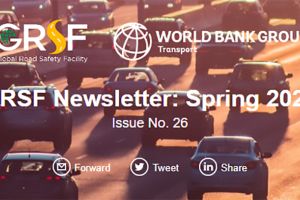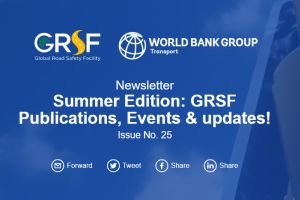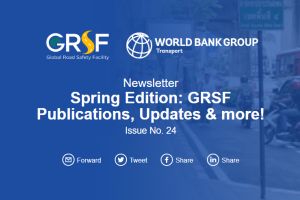Newsletter 20 | Get inspired: GRSF Summer 2021 Updates 📢 New research, events & more!
June 17, 2021

Low-speed Streets Save Lives! Join GRSF to Work for #StreetsForLife
 In a bid to help address the collective impact of speed as a contributor to crash risks, the World Bank’s Global Road Safety Facility (GRSF) celebrated the 6th UN Global Road Safety Week by hosting two high-level events and a global social media campaign.
In a bid to help address the collective impact of speed as a contributor to crash risks, the World Bank’s Global Road Safety Facility (GRSF) celebrated the 6th UN Global Road Safety Week by hosting two high-level events and a global social media campaign.
With this year’s theme “Streets for life: #Love30,” GRSF promoted key knowledge products and its Speed Management Hub that advocates and calls for action on low speed streets worldwide, limiting speeds to 30 km/h (20 mph) where people walk, live and play.
|
☑️ On May 19, GRSF hosted the high-level panel “Streets for Life: Saving Lives on the Road through Safe Speeds.” With an engaged audience of 5,700+ people across various platforms, the conversation shined new light on the amazing potential of global speed management initiatives to save lives on the road. |
☑️ On May 20, GRSF and the World Resources Institute (WRI) hosted the event “Empowering Communities to Manage Speed,” which marked the official launch of the Low-Speed Zone Guide. A pre-launch of an upcoming Global Speed Management Guide for policy makers was also presented. |
These activities marked an important milestone in the roadmap towards establishing the Second Decade of Action in Road Safety. The interactive events provided information and technical sessions on evidence-based road safety knowledge to help manage speeds through infrastructure interventions, effective enforcement, targeted awareness measures, and vehicle technology.
🎬 Speeding Hurts Us All – and the Impact is Life-changing ⌵︎
Meet Alexis & Maria 👋 They are the center of the story in this new video of the GRSF’s Speed Management Hub. Their story explains in a simple and animated way how a Safe System approach can be put in place to prevent the catastrophic consequences of road traffic injuries through speed management.
Join us in discovering how we can save lives on the road through safe speeds!
RESEARCH HIGHLIGHTS ⌵︎
📑 Low-speed Zone Guide: Empowering Communities and Decision makers to Plan, Design & Implement Effective Low-speed Zones
 To help address the collective impact of speed as a contributor to crash risks, the World Resources Institute and GRSF launched a new Low-Speed Zone Guide, which helps empower communities and decision-makers to plan, design and implement effective interventions.
To help address the collective impact of speed as a contributor to crash risks, the World Resources Institute and GRSF launched a new Low-Speed Zone Guide, which helps empower communities and decision-makers to plan, design and implement effective interventions.
The development of this guide was made possible through funding from Bloomberg Philanthropies. The guide presents strategies for planning, designing, building, and evaluating low-speed zones in cities. The report also intends to equip communities and decision-makers with the tools to implement low-speed zones within their specific context.
GRSF-FUNDED REPORTS ⌵︎
 Road Traffic Injuries in Malawi: With Special Focus on the Role of AlcoholDriving under the influence of alcohol is one of the principal reasons why road traffic crashes occur. The use of alcohol is also a risk factor for other road users, such as pedestrians and bicyclists. One major barrier to improving this situation is a lack of understanding of the problem related to driving under alcohol influence. To close this knowledge gap, the research project was developed with the financial support of UK Aid through GRSF and the partnership with the International Council on Alcohol Drugs and Traffic Safety and the Norwegian Council for Road Safety. The objective of the study was to generate new knowledge about road traffic injuries in Malawi and the extent of traffic accidents related to alcohol use, to increase capacity to conduct alcohol-testing, and develop a database for the findings, which in turn will form the basis for future policymaking to reduce traffic accidents. |
 Nigeria: The “Single Organization Road Safety” Institutional ModelThis study is one part of a comprehensive study of lead road safety agencies in low- and middle-income countries (LMICs), which is being conducted on a collaborative basis by the World Bank, the World Health Organization, and the African Development Bank. The study is made possible with financial support by UK Aid through the GRSF. It focuses on the case of Nigeria, a federal republic with three tiers of government - federal (central), state and local governments - and its single institutional model for road safety. The report responds to the following questions: What are the strengths and weaknesses of this model and what could be done to improve its efficiency and effectiveness? How efficient and effective is the “Single Organizational Model” institutional setup (both federal and state levels) in dealing with the road safety issues in Nigeria? Can this model be replicated in other LMICs and what are the factors that will determine the replicability of the model in those countries? What are the steps in setting up “Single Organizational Model” institutions in LMICs? |
📝 Road Safety Management Capacity Assessment for Samoa
 This Road Safety Management Capacity Assessment, funded by UK Aid through the GRSF, seeks to gain a broad understanding of the Government of Samoa road safety management capacity in order to support the country’s development of a new Samoa National Action Plan to improve road safety outcomes, and to then effectively implement those actions.
This Road Safety Management Capacity Assessment, funded by UK Aid through the GRSF, seeks to gain a broad understanding of the Government of Samoa road safety management capacity in order to support the country’s development of a new Samoa National Action Plan to improve road safety outcomes, and to then effectively implement those actions.
This assessment includes a focus on crash data management and a later activity will also support a pilot of the World Bank’s Data for Road Incident Visualization Evaluation and Reporting (DRIVER) crash database and provide hands on capacity building in crash analysis for Traffic Police under the Ministry of Police and Prisons.
» Download the report to learn more
PARTNERSHIPS TO SAVE LIVES ⌵︎
 Supporting Post-crash Response Capacity to Identify Priority Investments in Tajikistan, Kyrgyz, Lebanon & Egypt ⌵︎ On May 6, 2021 the EBRD and the EASST, with support from UK Aid through the GRSF, launched in Dushanbe, Tajikistan, a new training toolkit with resources to enhance the effectiveness of post-crash emergency medical and rescue operations. The toolkit includes six easy-to-follow video animations covering the key stages of the post-crash response lifecycle. It has been designed as a helpful resource for joint planning, to assist all stakeholders in the management of post-crash response to save lives and improve outcomes for survivors. |
 Supporting the Development of Active Transport Mobility in the Philippines ⌵︎ The Philippines government is committed to prioritizing Active Transport Mobility in their COVID-19 recovery plan and overall transport infrastructure development. The World Bank welcomed this initiative and agreed to support it by providing technical assistance thanks to grants from the Government of Australia and GRSF under the BIGRS program. Through this engagement, the World Bank is providing all key government agencies, local practitioners, and stakeholders with capacity building, mentoring and hands-on practice on bicycle infrastructure planning, development, and design, together with lifecycle asset management. |
 GRSF and the Vision Zero Academy Joined Forces to Introduce Vision Zero to Ukraine ⌵︎ On May 11, 2021, GRSF hosted the workshop “Introduction to Vision Zero for Ukraine” in collaboration with the Vision Zero Academy / Swedish Transport Administration and Reform Support Team at the Ministry of Infrastructure of Ukraine, under the BIGRS program. The workshop had the objective of engaging Ukrainian key stakeholders to the Vision Zero Academy – a global knowledge hub with the overall purpose to spread knowledge about the Vision Zero and to support and collaborate with different stakeholders around the world in their strive for safe road transport systems. |
UPCOMING EVENTS ⌵︎
✅ New webinar series: World Bank and iRAP helping save lives in Africa

The webinar series World Bank and iRAP helping save lives in Africa: BIGRS 2020-25 is designed to provide an introduction to iRAP to those in Africa who want to use the methodology to help eliminate high-risk roads, unlock the economic benefits of 3-star or better roads and meet Global Sustainable Development Goals (SDGs) and United Nations (UN) Targets. The focus of this introductory webinar will be on the road safety experience and lessons learned, and how to use iRAP methodology to do safety assessments across the region. The course is structured as a four-part series:
• Day 1 (Tuesday 06/07) – Introduction to BIGRS and iRAP in Africa
• Day 2 (Friday 09/07) –Introduction to ViDA
• Day 3 (Tuesday 13/07) –The iRAP Model
• Day 4 (Friday 16/07) –Case studies and establishing a RAP
Each session will have pre-reading materials and an assignment. Attendees will receive certificates upon successful completion of all activities.
GRSF IN ACTION ⌵︎
✅ GRSF Hosted Special Training Sessions at the 2021 World Bank Infrastructure Forum ⌵︎
 During the Infrastructure Forum 2021, GRSF hosted two special training sessions on May 25 & 27, 2021. In the first session “Road Safety Requirements Demystified,” the GRSF team shared practical hints from the Global Practice Note (GPN) and principles for use of road safety indicators in World Bank projects, illustrated by practical examples from recent World Bank projects. You can learn more about this topic in our Global Road Safety Tools page.
During the Infrastructure Forum 2021, GRSF hosted two special training sessions on May 25 & 27, 2021. In the first session “Road Safety Requirements Demystified,” the GRSF team shared practical hints from the Global Practice Note (GPN) and principles for use of road safety indicators in World Bank projects, illustrated by practical examples from recent World Bank projects. You can learn more about this topic in our Global Road Safety Tools page.
The second session “Assuring Safety in WB funded road projects: Use of Road Safety Screening & Appraisal Tool,” had the objective of explaining the Road Safety Screening & Appraisal Tool (RSSAT) in detail and provide practical hints and support to the World Bank staff with real case studies from recent projects.
✅ Global Webinar on Managing Traffic Speeds and Reaping Safety, Climate and Other Benefits ⌵︎
 On April 26, 2021, GRSF organized a webinar on “Managing Traffic Speeds and Reaping Safety, Climate and Other Benefits” as a pre-event for the 6th UN Global Road Safety Week. The primary objective of the webinar was to discuss building back better post-COVID 19, considering implementation of safe speeds through enforcement, communications, and road infrastructure. The webinar is part of the “Mobility and Development Series” organized by the Transport Global Practice at World Bank to discuss relevant topics with both internal and external audiences.
On April 26, 2021, GRSF organized a webinar on “Managing Traffic Speeds and Reaping Safety, Climate and Other Benefits” as a pre-event for the 6th UN Global Road Safety Week. The primary objective of the webinar was to discuss building back better post-COVID 19, considering implementation of safe speeds through enforcement, communications, and road infrastructure. The webinar is part of the “Mobility and Development Series” organized by the Transport Global Practice at World Bank to discuss relevant topics with both internal and external audiences.
The event had a global participation from over 180 transport practitioners, researchers and World Bank team leaders from different regions. The session was opened by the World Bank Infrastructure Vice President, Pablo Fajnzylber, and by WHO Director of Department of the Social Determinants of Health, Etienne Krug, along with presentations and panel participation from GRSP, WHO and WRI.
» Event’s recording & resources available here
✅ Saving Lives with Infrastructure: World Bank-GRSF Regional Course in Latin America ⌵︎
 During April 2021, GRSF organized the “Saving Lives with Infrastructure” course for leaders in the region involved in planning, financing, and delivery of road infrastructure. The objective of the course, delivered in partnership with Delft Road Safety Courses, was to provide tools for decision makers, managers and other officials involved in infrastructure to ensure road infrastructure is safe.
During April 2021, GRSF organized the “Saving Lives with Infrastructure” course for leaders in the region involved in planning, financing, and delivery of road infrastructure. The objective of the course, delivered in partnership with Delft Road Safety Courses, was to provide tools for decision makers, managers and other officials involved in infrastructure to ensure road infrastructure is safe.
The main audience were participants from national road safety agencies and units, ministries of infrastructure, national and city public works and mobility departments in Argentina, Brazil, Colombia, Ecuador, and Mexico.
MORE OF GRSF & PARTNERS ⌵︎
📰 What are the benefits & costs of different road speeds?What is the real cost of prioritizing cars over pedestrians? What are the implications of car-centric planning, and why the economic value of trips made by foot is not being considered? In this blog, GRSF provides answers, evidence-based arguments, and advocate for #StreetsForLife! » Read blog here 📰 ¡Velocidades Seguras! GRSF Promoting Safe Speeds in Latin AmericaOn the framework of the UNGRSW, GRSF participated in different events with partners in Latin America, including the International Panel “Calles 30: Mejorando la Seguridad Vial” in partnership with the Municipality of Lima (Peru), and the Webinar “Áreas 30 ou de Trânsito Calmo para reimaginar a cidade” in partnership with the City of São Paulo (Brazil). |
📰 GRSF Present at the Asia-Pacific Road Safety Observatory Annual MeetingOn April 21-22, 2021, the Asian Development Bank hosted the first annual meeting of the Asia Pacific Road Safety Observatory (APRSO). The invite-only virtual event served to discuss and seek agreement from 20 APRSO member countries on proposed minimum road safety performance indicators and agree steps towards establishing the APRSO road safety database. • On day 1, the meeting was focused on consistent data collection key to changing policy and saving lives. • On day 2 APRSO member countries appointed new National Data Coordinators.
|
📰 GRSF Partnered with GRSLC to Train BIGRS Implementing PartnersThe Global Road Safety Leadership Course (GRSLC) is coordinated and delivered by the Global Road Safety Partnership and the Johns Hopkins University’s International Injury Research Unit. During April 26th – June 7th, 2021, GRSF led two modules on speed reduction evidence-based approaches focusing on policy, enforcement, communications, infrastructure, and vehicle safety. The course welcomed 59+ participants from partner organizations of the BIGRS program, who are actively engaged in road safety activities. » Learn more her |

Read more! To stay up to date with GRSF's latest news and events, please subscribe to our newsletters clicking the link below.


